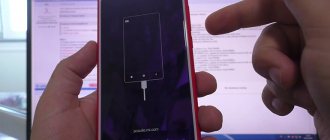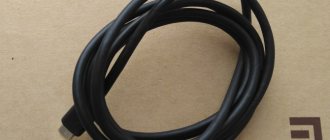Automatic cleaning of RAM
RAM overload is the number one reason why smartphones perform poorly. These consequences mainly lead to:
- incorrect operation of installed applications;
- simultaneous launch of several programs in the background;
- many automatically downloaded applications.
Also, due to the way Andriod works, often after the program is turned off, it continues to occupy part of the RAM. Therefore, it is not recommended to install many applications on one smartphone.
To free up RAM on Xiaomi, you need to:
- Open the “Security” section by clicking on the corresponding icon.
- Launch the "Acceleration" function. After this, a list of programs currently running will appear on the smartphone screen.
- Click on the open lock icon next to the application you want to turn off.
- Click on the “Accelerate” button.
To reduce the load on RAM, you should also set a limit on the number of running background programs. In this case, you need to select the appropriate value through the “For Developers” menu (located in the “Advanced Settings” section) (no more than one, two processes, and so on).
In addition, to launch the automatic cleaning function, in the “Security” section, click on the brush icon, and in the new window, move the slider opposite the “Check memory” line.
How did Xiaomi perform at work?
At the time of its release, Xiaomi Redmi 4 Prime caused an undisguised “wow” effect: a tightly built metal smartphone without a single gap, responding with lightning speed to every touch.
Before it, only Apple smartphones could boast of this quality of work. Even “pure” Android a couple of years ago did not work very well under load: frequent microlags and freezing of the shell became a kind of calling card for an actively used smartphone.
Without a cleaning program, any, even the most powerful smartphone, began to slow down after six months. Especially with “live wallpapers” and when actively scrolling through desktops.
At Xiaomi, lags did not appear either after a week, or after two, or after six months. Even now, the smartphone works as lightning fast as at the time of purchase.
There are often complaints about the company's smartphones: one thing, then another, then a third doesn't work. There is an algorithm in which shortcomings do not appear in any way: don’t go where you don’t understand anything.
Why reflash a stable smartphone that is updated once a month - stably, on its own, without a reminder? Moreover, why use third-party firmware for this?
On Stable firmware (there are also firmware for developers) there are no problems: the cameras work normally, Google services are stably available and power consumption is optimized.
A good daytime photo on Xiaomi Redmi 4 Prime Redmi 4 turned out to be an ideal working smartphone: taking photos on the road is not a problem, it works for 2 days without recharging and does not lose the network. If you don't use third-party firmware, of course.
Doesn't take good photos in the dark? Like all Adnroid smartphones under 30 thousand.
Doesn't show notifications from instant messengers? MIUI prohibits applications from everything, go to the settings and set the necessary permissions. But you can be sure that they won’t ask for too much.
Closes applications in the background? The same. And don't forget about the Energy Saving Manager.
Didn't like the update? Don’t put everything in a row, no one is forcing you.
And no problems. Just use your smartphone for everything it can do. Although there are no nuances, there are some pleasant ones.
Activity control
By default, Xiaomi smartphones are configured to reduce power consumption. This mode automatically controls the operation of applications, determining when they should go to sleep. But due to the fact that a number of installed programs, even after going to sleep, continue to load the RAM, the performance of the smartphone drops.
The Xiaomi operating system provides a function for setting up activity control. To do this, you need to go to the section of the same name, located along the path “Settings” - “Power and Performance”.
A list of installed programs will open in a new window. From this list, you should select a rarely used product. For such programs, you need to set a strict control mode. After this, the operating system will automatically reduce the impact of the application on the operation of the smartphone. For frequently used products, it is recommended to set the smart control mode.
Manual camera mode on Xiaomi
We have selected the optimal settings for photographs, now let’s talk about “Manual Mode” in the Xiaomi camera.
Manual mode allows you to adjust white balance and ISO. This mode is good to use in low light conditions.
- ISO – light sensitivity, has several options to choose from. The lower the value, the darker the photo will be; the higher, the brighter, but also the more “noise” appears.
- White balance can be selected manually for more accurate color reproduction.
All settings must be selected individually, depending on the situation.
Option to disable mobile internet
Some applications can function without constant access to the Internet. That is, this option helps reduce the load on the smartphone and thereby increase productivity. To disable Internet access, you need to:
- Open the “Security” section.
- Open the “Data Transfer” window.
- Click on “Traffic consumption”.
After this, a list will open with programs that are connected to the Internet. To disable access, you need to select the appropriate product and in the new window, move the sliders next to the “3G/4G”, “Wi-Fi” and “Background connection” items.
How to improve the quality of your photos
In addition to the standard settings, you should adhere to the following recommendations:
- Shoot only in good lighting conditions . Choose sunny days for outdoor photography. If you need high-quality photos indoors, use good artificial lighting.
- Don't forget about stabilization . Sudden movements when shooting lead to blurred images. Can't buy a monopod or tripod? Then turn the phone very slowly when recording video. Be sure to rest your elbows on a hard surface.
- Initially, purchase smartphones with good optics. If you are considering a phone as a full-fledged camera, only flagship models are suitable for you. You shouldn’t expect great photos from a public sector employee.
Google Pixel 2 Camera (APK)
To improve the quality of your photos, you can try third-party photography apps. For example, Google Pixel 2 . This software is downloaded from third-party services. The XDA Developers site is ideal for downloading.
- Download the application in an apk file;
- Install in the standard way;
- Set up the camera following the prompts on the screen.
Google Camera
A great alternative is Google Camera . There is a separate article where we describe in detail how and where to download the application, how to set up the Google camera and for what purposes it is suitable. Follow the link above and get acquainted with useful material!
What do you shoot most often?
Myself
31.79%
Environment
68.21%
Votes: 173
MIUI 12 optimization
The MIUI 12 optimization function is built into Xiaomi smartphones so that the operating system can independently control the load on the processor and RAM. Launching this option helps increase the productivity and operating time of mobile equipment.
To enable this feature, you must open the “For Developers” settings section. In the window that appears, you need to scroll the list to the end until the line with MIUI 12 optimization appears. At the end, you should move the slider.
After launching this function, according to the developer, the operating system will automatically reduce the load on the internal memory.
System
The smartphone runs on Android 11 with the MIUI 12 interface. It did not receive an update to version 12.5 at the time of writing this review, but visually these builds are still no different. Therefore, everything said in the Redmi Note 10 Pro review is also relevant for this model.
In short, it still has the same intrusive advertising, excellent dark mode, flexible desktop settings, two types of notification curtains to choose from, and convenient floating windows.
With all this, Redmi Note 10 does not have problems with navigation buttons, freezes and application operation, like the Pro version. The system works stably and without any errors. There is nothing to complain about.
Device update
The performance of Xiaomi smartphones can be improved by regularly updating the system. The developers of the Chinese company are constantly improving their products, adding options that increase productivity. However, in some cases the opposite situation arises. Bugs in released updates reduce the performance of the phone.
To speed up the operation of the device, you need to:
- Go to the settings section and select “About phone”.
- Click on the “System Update” tab and wait until the device checks for available updates.
- Click on the “Download updates” button, which appears if the system finds new assemblies.
After completing the described manipulations, the phone will automatically reboot.
Camera
The smartphone has four cameras on the back, the main one of which has a 48 MP Sony IMX582 sensor with phase focus. This is a very successful module that Xiaomi installed in Mi 9T and Mi A3. It copes well with daytime shooting. Judge for yourself.
Photo taken with the main camera (to view in full resolution, open in the next tab):
In low light, the camera easily loses focus, but does not distort colors. Therefore, you can still get the desired shot at dusk or with dim light if you get into the habit of taking a series of shots for each scene.
By default, the camera shoots in 12 megapixel resolution; full 48 megapixels are enabled in the settings. A night shooting mode is also available there, which will most likely be in demand only in rare cases, since it greatly highlights the picture and makes it unnatural.
Portrait photography:
The smartphone takes portraits well. An additional 2 MP camera helps with them, determining the depth of field. Like other Xiaomi smartphones, Redmi Note 10 allows you to change the level of background blur in any frame taken in portrait mode.
The 8MP wide-angle camera can be useful for shooting daytime landscapes or even sunsets, but you shouldn't expect much more from it. As the amount of light decreases, the edges of the frame begin to noticeably lose sharpness, and dynamic objects almost always turn out blurry.
Photos with a wide-angle camera:
The fourth camera - 2 megapixel - does not deserve special attention. There is not even a special mode for it in the shooting menu. If you need to take a close-up photo of a miniature object, then a crop from the main camera is better suited for this.
For selfies, there is a 13 megapixel module with 1.12µm pixels. This camera pleasantly surprised us with its color reproduction, portrait mode and automatic HDR, which turns on when you really need it.
Uninstalling apps
By removing installed programs, you can free up the built-in memory, which will have a positive effect on the performance of mobile devices. To perform this procedure, you need to go to the settings section and open the “All applications” tab.
After this, a list will appear on the screen containing all installed programs, including those that were loaded by default by the manufacturer. Users can:
- disable the program;
- remove updates;
- remove the program.
Each of the described actions results in the release of built-in memory. However, some pre-installed applications cannot be deleted. In this case, you should disable the product. It is also not recommended to remove system applications, which may negatively affect the operation of mobile equipment.
Autonomy and charging
In terms of autonomy, this model is also superior to its “big brother”, which is quite logical, because Redmi Note 10 does not have a power-hungry display with a frequency of 120 Hz. Here is a regular AMOLED panel at 60 Hz, with which the battery charge does not melt before our eyes. With everyday use, you can always remain confident that you will definitely have enough food until the evening.
If you try to squeeze all the juice out of a 5,000 mAh battery during daylight hours by actively using the camera, watching online videos and chatting in a couple of instant messengers, you can count on about 6–7 hours of active screen time. This is a decent indicator.
Photo: Victor Podvolotsky / Lifehacker
Full charging time at maximum power (33 W) via USB‑C is approximately 1.5 hours, and the battery will be charged to 50% in 25–30 minutes. This speed allows you not to worry if you don’t charge your smartphone overnight. This can be done in the morning while you are getting ready for work or school.
Disable animation
Enabled animation consumes a lot of RAM. If the phone is overloaded, the system performance will be reduced due to such an application. To disable animation, you also need to go to the “For Developers” section.
Next, you need to open the menu with parameters and the “Advanced” item. Here you should select “Optimization”. A list of quick settings will appear in a new window. In this section, you need to move the slider opposite the “Window Animation” item.
Clearing cache
It is necessary to constantly clean the cache, or the area in the built-in memory reserved for temporary files. The information that accumulates here slows down the smartphone over time. Xiaomi phones automatically carry out this procedure. But due to the nature of some applications, this is not enough.
The following methods are used to clear the cache:
- Selective. To delete temporary files, you need to go to the settings section and click on the item with the name of the application. In the new window, click on “Clear cache”.
- Through the Memory Cleaner application. This program sometimes deletes some temporary files.
- Through storage. In this section at the bottom there is a “Clear” button, by clicking on which you can delete temporary files.
To clear the cache, you can use the “Security” function, after launching which the system will check the memory for “garbage” and offer to delete temporary files.
Design and ergonomics
Photo: Victor Podvolotsky / Lifehacker
Externally, the smartphone resembles a slightly smaller version of Pro. True, if the Note 10 Pro has a glass back panel, then the Note 10 is made of plastic, as are the ends of the case. The cover perfectly collects fingerprints and other stains, which is especially noticeable on a steel-colored device.
Xiaomi Redmi Note 10 (bottom) and Redmi Note 10 Pro (top). Photo: Victor Podvolotsky / Lifehacker
In addition, if in the Pro version the main camera module is located on two “steps,” then in the basic version it’s all on one. At the same time, the block with lenses and the frame with the flash are covered not with a single glass, but with different ones. The joint between them can become an excellent place for dust to accumulate over time.
Photo: Victor Podvolotsky / Lifehacker
On the right side of the device there is a power button with a fingerprint scanner. Its matte surface visually stands out against the glossy end, but at first it is quite difficult to feel this element blindly. The button is narrow and its height almost coincides with the level of the edge itself. You have to get used to this.
Photo: Victor Podvolotsky / Lifehacker
In general, the smartphone fits well in the hand, but carrying it in a trouser pocket without a case is quite dangerous. As soon as you sit down somewhere—in a car or office—the gadget will happily slide out of your pocket onto the floor. Considering that the plastic case is easily scratched, it is better not to risk it.
GPS optimization
Some installed programs connect to GPS to determine the location of the smartphone. This option partially overloads the memory and processor. To disable this feature, you need to open the “Location” section in the settings and select “Allowed only for applications.”
After this operation is completed, the firmware will only run GPS in the active state. If necessary, you can prevent some installed applications from using this function.
What's next for this smartphone?
Here's another reason to buy Xiaomi - they sell well on the secondary market. My Redmi 4 Prime served me well, and now I’m off to Avito.
A smartphone in perfect condition loses about 25% of its value when sold secondhand. Moreover, not from the original one: the original price must be calculated from the market price, the average for Avito. This is a couple thousand higher than in China.
With an initial price of 10,000 rubles, a state employee loses no more than 1000-2000 if it was purchased in China not at the start of sales, but for an adequate price.
If at the time of sale the next generation appears (as in my case, when Redmi 5 is current), the price is reduced by another 10-15%.
Likewise, the value drops when there is damage. Why so little? Because Xiaomi components are very cheap. The assembled screen can be purchased for 1500-2000 rubles, the body for 1000.
Therefore, now the market price of my Redmi 4 Prime with a few scratches balances in the range of 6000-8000 rubles from the original 10,000.
Like an iPhone!
Disabling Wi-Fi Assistant in MIUI 12
This assistant constantly scans the surrounding area in the background in order to search for available Wi-Fi networks with a more stable signal. This feature also automatically switches between 3G and 4G, depending on which channel provides fast information transfer.
This assistant should be disabled when the smartphone is in an area with a strong signal. This can be done through the settings section by opening the “Wi-Fi” menu and deactivating the function.











